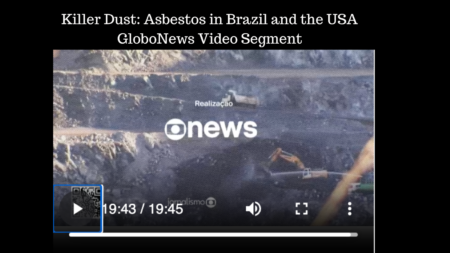Posted on July 1, 2024
 GloboNews’ recently aired segment, “Cities and Solutions,” provided an eye-opening investigation of the devastating impacts of asbestos on Brazil. As your neighbor and fellow citizen, and as someone whose life was turned upside down by asbestos, I felt compelled to share what I learned and start a conversation about this critical issue affecting our health and communities. What is happening in Brazil does not stay in Brazil, but crosses borders and affects us here in the US too.
GloboNews’ recently aired segment, “Cities and Solutions,” provided an eye-opening investigation of the devastating impacts of asbestos on Brazil. As your neighbor and fellow citizen, and as someone whose life was turned upside down by asbestos, I felt compelled to share what I learned and start a conversation about this critical issue affecting our health and communities. What is happening in Brazil does not stay in Brazil, but crosses borders and affects us here in the US too.
First, thank you to ABREA and their colleagues for the amazing work they have done and continue to do in Brazil and around the world. Click here to read ARBEA’s blog and watch the video.
The program introduced us to three former asbestos workers — Mr. Ailton, Mr. José Carlos, and Mr. Sérgio. Their stories are heartbreaking. Years of working in asbestos tile and water tank factories have left them with severe health issues. They described working in dust-filled environments, often without proper protection, unaware of the dangers surrounding them daily.
 One worker poignantly shared, “I have dust in my lungs, and this is serious.” Another mentioned sleeping on asbestos sacks during breaks, not knowing the harm it was causing. These personal accounts bring home the true human cost of asbestos use. We know there is no safe level of asbestos exposure, and while it may take years for problems to arise, the cost of using this dangerous chemical is just too high. Asbestos causes illnesses including mesothelioma, asbestosis, and cancers of the lung, larynx, and ovaries.
One worker poignantly shared, “I have dust in my lungs, and this is serious.” Another mentioned sleeping on asbestos sacks during breaks, not knowing the harm it was causing. These personal accounts bring home the true human cost of asbestos use. We know there is no safe level of asbestos exposure, and while it may take years for problems to arise, the cost of using this dangerous chemical is just too high. Asbestos causes illnesses including mesothelioma, asbestosis, and cancers of the lung, larynx, and ovaries.
Until recently, Brazil was the world’s third-largest producer and exporter of asbestos. The mineral was widely used in tiles, water tanks, and pipes. This widespread use has left a toxic legacy that continues to affect us today.
The chlor-alkali industry has been the primary asbestos importers and users since 2011. Until recently, the majority of the US imports came from Brazil. Shamefully, America is responsible for impacting the health of Brazilians.
Recently, the Brazilian Supreme Federal Court banned chrysotile asbestos in the country. However, the fight isn’t over. Some state laws still allow for asbestos mining and export, creating a legal contradiction that will continue to put workers and communities at risk from deadly asbestos.
Even with a ban on new asbestos, legacy (or older asbestos found in homes, schools, and workplaces across Brazil) remains a significant concern, putting health and safety at risk. Broken tiles on street corners and old water tanks in our homes pose risks of asbestos exposure to our children and families. The lack of public awareness and proper guidance on safely handling or removing asbestos-containing materials creates even more of a risk for communities.
Millions of buildings in the US also have legacy asbestos in their walls and ceilings. This is particularly dangerous during natural disasters (which are increasing due to climate change), home renovations, or accidents.
Thank you to GloboNews for including Dr. Raja Flores and me in this important piece.
Together, we make change happen.
Linda Reinstein
